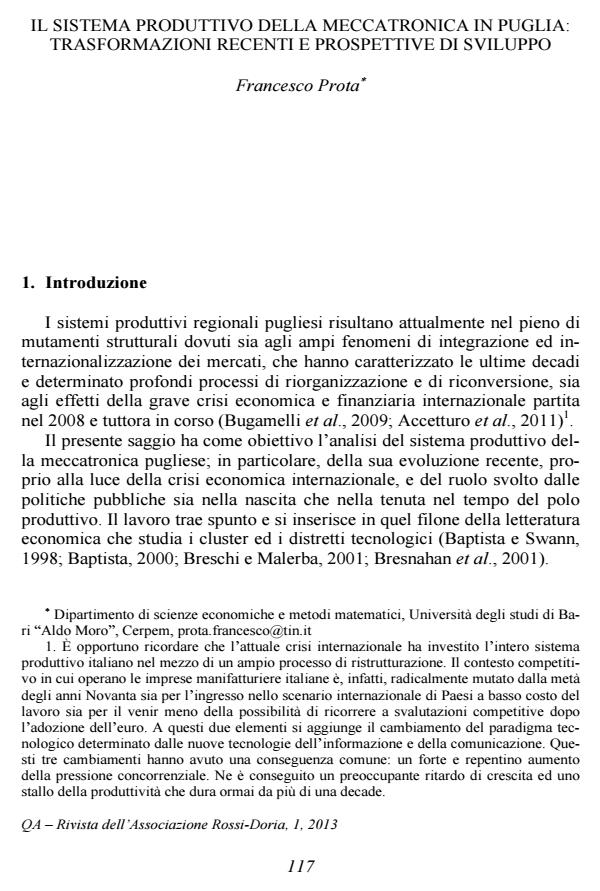The Apulian Mechatronics District: Recent Changes and Development Prospects
Journal title QA Rivista dell’Associazione Rossi-Doria
Author/s Francesco Prota
Publishing Year 2013 Issue 2013/1 Language Italian
Pages 26 P. 117-142 File size 337 KB
DOI 10.3280/QU2013-001005
DOI is like a bar code for intellectual property: to have more infomation
click here
Below, you can see the article first page
If you want to buy this article in PDF format, you can do it, following the instructions to buy download credits

FrancoAngeli is member of Publishers International Linking Association, Inc (PILA), a not-for-profit association which run the CrossRef service enabling links to and from online scholarly content.
This paper analyses the Apulian mechatronics district, and in particular recent developments during the global economic crisis that began in 2008, as well as the role played by public policies in favouring the birth and endurance of the local production system. Although it is going through a delicate phase, the local production system has the potential for further development. An important role in supporting its development can be played by public policies with measures designed, on the one hand, to increase the number of economic players and, on the other hand, to boost the technological content and competitiveness of local enterprises. EconLit Classification: R110, O180, L220
Keywords: Technological districts, Economic crisis, Public policies
- Accetturo A., Giunta A., Rossi S. (2011), «Le imprese italiane tra crisi e nuova globalizzazione», L’industria, 1, pp. 145-163. DOI: 10.1430/34268
- Arthur W.B. (1994), Increasing Returns and Path Dependence in the Economy, University of Michigan Press, Ann Arbor, Mi
- Arti (2007), Il Distretto pugliese della Meccatronica, Medis, Quaderno 2, giugno
- Baptista R. (2000), «Does Innovation Diffuse Faster within Geographical Cluster? », International Journal of Industrial Organization, 18, pp. 515-535
- Baptista R., Swann P. (1998), «Do Firms in Cluster Innovate More?», Research Policy, 27, pp. 527- 542
- Breschi S., Malerba F. (2001), «The Geography of Innovation and Economic Clustering: Some Introductory Notes», Industrial and Corporate Change, 10, pp. 817-833
- Bresnahan T., Gambardella A., Saxenian A. (2001), «Old Economy’ Inputs for “New Economy” Outcomes: Cluster Formation in the New Silicon Valleys», Industrial and Corporate Change, 10, pp. 835-860
- Bugamelli M., Cristadoro R., Zevi G. (2009), «La crisi internazionale e il sistema produttivo italiano: un’analisi su dati a livello d’impresa», Questioni di Economia e Finanza, Banca d’Italia, 58
- Centro studi Confindustria (2011), Effetti della crisi, materie prime e rilancio manifatturiero. Le strategie di sviluppo delle imprese italiane, Scenari industriali 2, giugno
- Colombo M.G., Grilli L., Murtinu S. (2011), «R&D Subsidies and the Performance of High Tech Start Ups», Economics Letters, 112, pp. 97-99
- Colombo M.G., Giannangeli S., Grilli L. (2012), «Public Subsidies and the Growth of High Tech Start ups: Assessing the Impact of Selective and Automatic Support Schemes», Industrial and Corporate Change (disponibile online: 9 novembre 2012, 10.1093/icc/dts037).
- Coniglio N.D., Mariano E., Prota F. (2011), Capitale umano, mobilità geografica e sviluppo economico. Analisi e politiche per la Puglia, Manni, San Cesario di Lecce.
- Etzkowitz H., Leydesdorff L. (eds.) (1997), Universities and the Global Knowledge Economy: A Triple Helix of University–Industry–Government Relations, Pinter, London
- Etzkowitz H., Leydesdorff L. (2000), «The Dynamics of Innovation: From National Systems and “Mode 2” to a Triple Helix of University-Industry-Government Relations», Research Policy, 29, pp. 109-123
- Florida, R., Kenney M. (1988), «Venture Capital Financed Innovation and Technological Change in the USA», Research Policy, 17, pp. 119-137
- Hirschman A.O. (1958), The Strategy of Economic Development, Yale University Press, New Haven, Conn.
- Lerner J. (1999), «The Government as Venture Capitalist: The Long-Run Impact of the SBIR Program», Journal of Business, 72, pp. 285-318
- Prota F., Rosato P. (2007), «La presenza nel contesto economico della Puglia delle imprese multinazionali: il caso del polo della componentistica per auto di Modugno e di quello della chimica di Brindisi», in SRM e Istituto Affari Internazionali, L’economia pugliese e le nuove sfide dell’internazionalizzazione produttiva, Giannini, Napoli, pp. 167-222.
- I contratti di rete: valutazioni oltre l'emergenza Laura Azzolina, in STUDI ORGANIZZATIVI 1/2018 pp.40
DOI: 10.3280/SO2018-001002 - Attori economici e istituzioni locali nelle iniziative a sostegno del settore auto nel mezzogiorno Davide Bubbico, in QA Rivista dell'Associazione Rossi-Doria 4/2014 pp.43
DOI: 10.3280/QU2013-004002 - Mental maps of entrepreneurs and location factors: an empirical investigation on Italy Dario Musolino, Ilaria Mariotti, in The Annals of Regional Science /2020 pp.501
DOI: 10.1007/s00168-019-00907-0 - The North-South Divide in Italy: Reality or Perception? Dario Musolino, in European Spatial Research and Policy /2018 pp.29
DOI: 10.18778/1231-1952.25.1.03
Francesco Prota, Il sistema produttivo della meccatronica in Puglia: trasformazioni recenti e prospettive di sviluppo in "QA Rivista dell’Associazione Rossi-Doria" 1/2013, pp 117-142, DOI: 10.3280/QU2013-001005